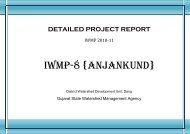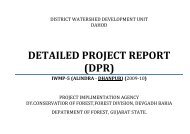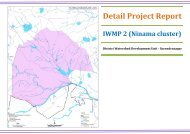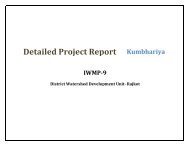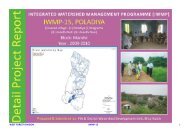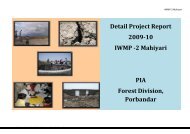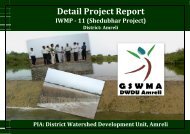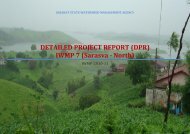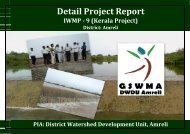Detailed Project Report - Commissionerate of Rural Development ...
Detailed Project Report - Commissionerate of Rural Development ...
Detailed Project Report - Commissionerate of Rural Development ...
You also want an ePaper? Increase the reach of your titles
YUMPU automatically turns print PDFs into web optimized ePapers that Google loves.
District Watershed <strong>Development</strong> Unit - Jamnagar<br />
Production System - 5 : Vermicomposting unit<br />
Introduction:<br />
The process <strong>of</strong> composting crop residues using earthworms comprise spreading the agricultural wastes and cow dung in layers as<br />
1.5 m wide and 0.9 m high beds <strong>of</strong> required length. Earthworms are introduced in between the layers @ 350 worms per m 3 <strong>of</strong> bed<br />
volume. The beds are maintained at about 40 - 50% moisture content and a temperature <strong>of</strong> 20 - 30° C by sprinkling water over the<br />
beds. The earthworms being voracious eaters consume the biodegradable matter and give out a part <strong>of</strong> the matter as excreta or<br />
vermi-castings. The vermi-casting containing nutrients are rich manure for the plants.<br />
About The Worms<br />
Eisenia fetida, Eudrilus eugeniae, and Perionyx excavatius are some <strong>of</strong> the species for rearing to convert organic wastes into manure. The<br />
worms feed on any biodegradable matter ranging from coir waste to kitchen garbage and Vermicomposting units are ideally suited to locations /<br />
units with generation <strong>of</strong> considerable quantities <strong>of</strong> organic wastes. One earthworm reaching reproductive age <strong>of</strong> about six weeks lays one egg<br />
capsule (containing 7 embryos) every 7 - 10 days. Three to seven worms emerge out <strong>of</strong> each capsule. Thus, the multiplication <strong>of</strong> worms under<br />
optimum growth conditions is very fast. The worms live for about 2 years. Fully grown worms could be separated and dried in an oven to make<br />
'worm meal' which is a rich source <strong>of</strong> protein (70%) for use in animal feed.<br />
Location<br />
Patan <strong>Project</strong> has lots <strong>of</strong> animals so it can become good vermi compost center as well as good source <strong>of</strong> livelihood. Vermicompost is<br />
very suitable for fruit, flower and vegetable as well as cereal crops. It increases quality and quantity <strong>of</strong> product in per unit area.<br />
<strong>Detailed</strong> <strong>Project</strong> <strong>Report</strong> – IWMP-1 (Patan )



